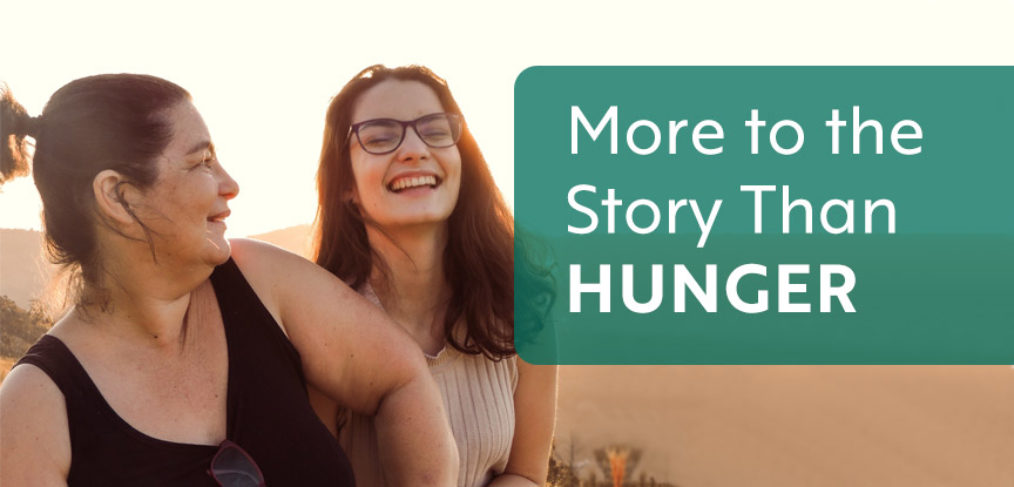
More to the Story
By Rebecca Thuro & Food Justice Team
“Mom, can I go my friend’s birthday at the rec centre on Friday?” says Katrina to her mother Tricia. Tricia wants with all her heart for her daughter to be able to experience the joy of celebrating her friend, but she has a dilemma. The car ride to the rec centre is across town, and a birthday gift is out of the question. The last she checked, there was $20 in the bank, gas in the car was on empty and the fridge was looking bare. Friday’s pay day felt very far away.
Tricia and her partner both work two part time jobs to be able to keep food in the fridge, a roof over their heads and gas in the car for their family of 7. “Sorry sweetie, I don’t think it’s going to work this week.” Tricia is forced to make the hard choice to say no to her daughter’s joy and limit her daughter’s social support. Hopefully there won’t be any more unexpected costs before payday so the family will have enough to put a little gas in the car and pick up some milk and bread.
This tough choice triggers Tricia’s childhood memory of growing up in a house with a parent who struggled with substance misuse. She remembers cupboards were empty on a regular basis. Tricia and her partner have had to face many inequalities experienced by countless others in her Indigenous community. She wants her children to know the strength of her community and has worked so hard to create a different experience for her children, and yet she still finds herself food insecure.
Food insecurity is so much more than not having enough to eat; it is a complex social issue. For many, food insecurity has been believed to be an issue of the individual and not that of the system. Like Tricia and her partner, 65% of those experiencing food insecurity are working. With the gap between wages and the costs of living growing immensely, many individuals are left unable to afford food. Household food insecurity in Canada is tightly linked to income. As you would expect, when a household’s income declines, the risk of food insecurity increases.
Food insecurity is so much more than not having enough to eat; it is a complex social issue.
The impact of inequalities are baked into the system and food insecurity largely impacts marginalized communities, as well as restricts access to nutritious, culturally appropriate foods. In Tricia’s experience, her community was suffering from the impact of the colonial system of residential schools. Access to the supports her family needed while she was a child were glaringly absent, she grew up unjustly learning to navigate through institutional racism.
There is a social stigma that exists regarding access to food services like the Food Bank. This also plays a major role in food insecurity as many feel as though not being able to provide for oneself and one’s family is solely their fault and seeking help is shameful. This is why we are making efforts to shift the dialogue around accessing food at the Food Bank. Over the pandemic we have made efforts to remove barriers to food and increase access.
One of the changes was to remove income testing. Previously income testing reflected the government low-income measurements. This testing didn’t take into account the true cost of living in the lower mainland and became a barrier to accessing food. Tricia made the decision to access the Food Bank for the first time in a long time during the pandemic. When she went she feared that she would not qualify to access the food her family needed and even contemplated misrepresenting her family to qualify.
Since accessing food at the Food Bank, she told us that she hasn’t had to choose between a tank of gas and groceries.
When she found that there was not an income test, she was greatly relieved to be able to be open and honest about her situation. Since accessing food at the Food Bank, she told us that she hasn’t had to choose between a tank of gas and groceries. The amount of food is just enough that she needs to bridge the gap between pay cheques. While the Food Bank is happy to be able to bridge the gap, we know our food services are an important part to play while our community and social network seeks changes in the social, economic, and environmental conditions that affect the costs of food production and distribution, as well as people’s income and ability to afford food.
Together with volunteers, advocates, donors, funders, and staff we all have a part to play in creating access to food and wrap around service that allows opportunity for everyone to meaningfully engage in our community. Thank you for your continued engagement, we couldn’t do it without you!
Please note the names have been changed and stock photo used (Photo by ☀️Shine_ Photos) to keep family anonymous. Story shared with permission.

